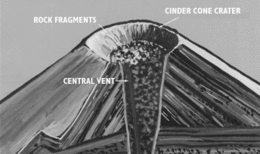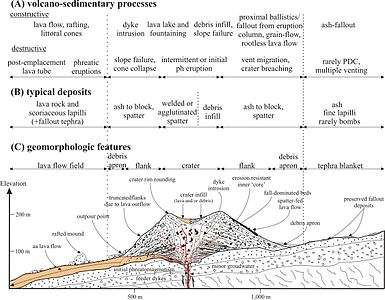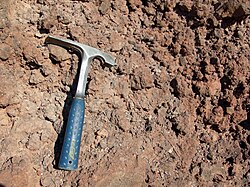Cinder cone

Acinder cone(orscoria cone[1]) is a steepconical hillof loosepyroclasticfragments, such as volcanic clinkers, volcanic ash, orscoriathat has been built around avolcanic vent.[2][3]The pyroclastic fragments are formed by explosive eruptions orlava fountainsfrom a single, typically cylindrical, vent. As the gas-charged lava is blown violently into the air, it breaks into small fragments that solidify and fall as either cinders, clinkers, or scoria around the vent to form a cone that often is symmetrical; with slopes between 30 and 40°; and a nearly circular ground plan.[4]Most cinder cones have a bowl-shapedcraterat the summit.[2]
Mechanics of eruption
[edit]
Cinder cones range in size from tens to hundreds of meters tall.[3]They are composed of loose pyroclastic material (cinderorscoria), which distinguishes them fromspatter cones,which are composed of agglomeratedvolcanic bombs.[5]
The pyroclastic material making up a cinder cone is usuallybasaltictoandesiticin composition.[6]It is oftenglassyand contains numerous gas bubbles "frozen" into place asmagmaexploded into the air and then cooled quickly. Lava fragments larger than 64 mm across, known asvolcanic bombs,are also a common product of cinder cone eruptions.[3]
The growth of a cinder cone may be divided into four stages. In the first stage, a low-rimmed scoria ring forms around the erupting event. During the second stage, the rim is built up and atalus slopebegins to form outside the rim. The third stage is characterized by slumping and blasts that destroy the original rim, while the fourth stage is characterized by the buildup of talus beyond the zone where cinder falls to the surface (theballistic zone).[7]
During the waning stage of a cinder cone eruption, the magma has lost most of its gas content. This gas-depleted magma does not fountain but oozes quietly into the crater or beneath the base of the cone as lava.[8]Lava rarely issues from the top (except as a fountain) because the loose, uncemented cinders are too weak to support the pressure exerted by molten rock as it rises toward the surface through the central vent.[3]Because it contains so few gas bubbles, the molten lava is denser than the bubble-rich cinders.[8]Thus, it often burrows out along the bottom of the cinder cone, lifting the less dense cinders like corks on water, and advances outward, creating alava flowaround the cone's base.[8]When the eruption ends, a symmetrical cone of cinders sits at the center of a surrounding pad of lava.[8]If the crater is fully breached, the remaining walls form an amphitheater or horseshoe shape around the vent.
Occurrence
[edit]
Basaltic cinder cones are the most characteristic type of volcano associated withintraplate volcanism.[9]They are particularly common in association withalkaline magmatism,in which the erupted lava is enriched insodiumandpotassium oxides.[10]
Cinder cones are also commonly found on the flanks ofshield volcanoes,stratovolcanoes,andcalderas.[3]For example, geologists have identified nearly 100 cinder cones on the flanks ofMauna Kea,a shield volcano located on the island ofHawaii.[3]Such cinder cones likely represent the final stages of activity of amaficvolcano.[11]However, most volcanic cones formed inHawaiian-type eruptionsare spatter cones rather than cinder cones, due to the fluid nature of the lava.[12]
The most famous cinder cone,Paricutin,grew out of a corn field inMexicoin 1943 from a new vent.[3]Eruptions continued for nine years, built the cone to a height of 424 meters (1,391 ft), and produced lava flows that covered 25 km2(9.7 sq mi).[3]
The Earth's most historically active cinder cone isCerro Negroin Nicaragua.[3]It is part of a group of four young cinder cones NW ofLas Pilasvolcano. Since its initial eruption in 1850, it has erupted more than 20 times, most recently in 1995 and 1999.[3]
Satellite images suggest that cinder cones occur on other terrestrial bodies in the solar system.[13]On Mars, they have been reported on the flanks ofPavonis MonsinTharsis,[14][15]in the region ofHydraotes Chaos[16]on the bottom of theCoprates Chasma,[17]or in the volcanic fieldUlysses Colles.[18]It is also suggested that domical structures inMarius Hills(on the Moon) might representlunarcinder cones.[19]
Effect of environmental conditions
[edit]
The size and shape of cinder cones depend on environmental properties as different gravity and/or atmospheric pressure might change the dispersion of ejected scoria particles.[13]For example, cinder cones on Mars seem to be more than two times wider than terrestrial analogues[18]as lower atmospheric pressure and gravity enable wider dispersion of ejected particles over a larger area.[13][20]Therefore, it seems that erupted amount of material is not sufficient on Mars for the flank slopes to attain theangle of reposeand Martian cinder cones seem to be ruled mainly by ballistic distribution and not by material redistribution on flanks as typical on Earth.[20]
Cinder cones often are highly symmetric, but strong prevailing winds at the time of eruption can cause a greater accumulation of cinder on the downwind side of the vent.[11]
Monogenetic cones
[edit]
Some cinder cones aremonogenetic,forming from a single short eruptive episode that produces a very small volume of lava. The eruption typically last just weeks or months, but can occasionally last fifteen years or longer.[21]Parícutinin Mexico,Diamond Head,Koko Head,Punchbowl Crater,Mt Le Brun from the Coalstoun Lakes volcanic field,and some cinder cones on Mauna Kea are monogenetic cinder cones. However, not all cinder cones are monogenetic, with some ancient cinder cones showing intervals of soil formation between flows that indicate that eruptions were separated by thousands to tens of thousands of years.[21]
Monogenetic cones likely form when the rate of magma supply to a volcanic field is very low and the eruptions are spread out in space and time. This prevents any one eruption from establishing a system of "plumbing"that would provide an easy path to the surface for subsequent eruptions. Thus each eruption must find its independent path to the surface.[22][23]
See also
[edit]- List of cinder cones
- Volcanic cone– Landform of ejecta from a volcanic vent piled up in a conical shape
- Capulin Volcano National Monument– U.S. National Monument in New Mexico
References
[edit]- ^Allaby, Michael (2013). "cinder cone".A dictionary of geology and earth sciences(Fourth ed.). Oxford: Oxford University Press.ISBN9780199653065.
- ^abPoldervaart, A (1971). "Volcanicity and forms of extrusive bodies". In Green, J; Short, NM (eds.).Volcanic Landforms and Surface Features: A Photographic Atlas and Glossary.New York: Springer-Verlag. pp. 1–18.ISBN978-3-642-65152-6.
- ^abcdefghij
 This article incorporatespublic domain materialfromPhoto glossary of volcano terms: Cinder cone.United States Geological Survey.
This article incorporatespublic domain materialfromPhoto glossary of volcano terms: Cinder cone.United States Geological Survey.
- ^Clarke, Hilary; Troll, Valentin R.; Carracedo, Juan Carlos (2009-03-10)."Phreatomagmatic to Strombolian eruptive activity of basaltic cinder cones: Montaña Los Erales, Tenerife, Canary Islands".Journal of Volcanology and Geothermal Research.Models and products of mafic explosive activity.180(2): 225–245.Bibcode:2009JVGR..180..225C.doi:10.1016/j.jvolgeores.2008.11.014.ISSN0377-0273.
- ^Fisher, R.V.; Schmincke, H.-U. (1984).Pyroclastic rocks.Berlin: Springer-Verlag. p. 96.ISBN3540127569.
- ^Jackson, Julia A., ed. (1997). "cinder cone".Glossary of geology(Fourth ed.). Alexandria, Virginia: American Geological Institute.ISBN0922152349.
- ^Fisher & Schmincke 1984,p. 150.
- ^abcd
 This article incorporatespublic domain materialfromSusan S. Priest; Wendell A. Duffield; Nancy R. Riggs; Brian Poturalski; Karen Malis-Clark (2002).Red Mountain Volcano – A Spectacular and Unusual Cinder Cone in Northern Arizona.United States Geological Survey.USGS Fact Sheet 024-02.Retrieved2012-05-18.
This article incorporatespublic domain materialfromSusan S. Priest; Wendell A. Duffield; Nancy R. Riggs; Brian Poturalski; Karen Malis-Clark (2002).Red Mountain Volcano – A Spectacular and Unusual Cinder Cone in Northern Arizona.United States Geological Survey.USGS Fact Sheet 024-02.Retrieved2012-05-18.
- ^Fisher & Schmincke 1984,p. 14.
- ^Fisher & Schmincke 1984,p. 198.
- ^abMonroe, James S.; Wicander, Reed (1992).Physical geology: exploring the Earth.St. Paul: West Pub. Co. p. 98.ISBN0314921958.
- ^Macdonald, Gordon A.; Abbott, Agatin T.; Peterson, Frank L. (1983).Volcanoes in the sea: the geology of Hawaii(2nd ed.). Honolulu: University of Hawaii Press. pp. 16–17.ISBN0824808320.
- ^abcWood, C.A. (1979). "Cinder cones on Earth, Moon, and Mars".Lunar Planet. Sci.Vol. X. pp. 1370–72.Bibcode:1979LPI....10.1370W.
{{cite book}}:|journal=ignored (help) - ^Bleacher, J.E.; Greeley, R.; Williams, D.A.; Cave, S.R.; Neukum, G. (2007). "Trends in effusive style at the Tharsis Montes, Mars, and implications for the development of the Tharsis province".J. Geophys. Res.112(E9): E09005.Bibcode:2007JGRE..112.9005B.doi:10.1029/2006JE002873.
- ^Keszthelyi, L.; Jaeger, W.; McEwen, A.; Tornabene, L.; Beyer, R.A.; Dundas, C.; Milazzo, M. (2008). "High Resolution Imaging Science Experiment (HiRISE) images of volcanic terrains from the first 6 months of the Mars Reconnaissance Orbiter primary science phase".J. Geophys. Res.113(E4): E04005.Bibcode:2008JGRE..113.4005K.CiteSeerX10.1.1.455.1381.doi:10.1029/2007JE002968.
- ^Meresse, S; Costard, F; Mangold, N.; Masson, Philippe; Neukum, Gerhard; the HRSC Co-I Team (2008). "Formation and evolution of the chaotic terrains by subsidence and magmatism: Hydraotes Chaos, Mars".Icarus.194(2): 487.Bibcode:2008Icar..194..487M.doi:10.1016/j.icarus.2007.10.023.
- ^Brož, Petr; Hauber, Ernst; Wray, James J.; Michael, Gregory (2017)."Amazonian volcanism inside Valles Marineris on Mars".Earth and Planetary Science Letters.473:122–130.Bibcode:2017E&PSL.473..122B.doi:10.1016/j.epsl.2017.06.003.
- ^abBrož, P; Hauber, E (2012). "A unique volcanic field in Tharsis, Mars: Pyroclastic cones as evidence for explosive eruptions".Icarus.218(1): 88–99.Bibcode:2012Icar..218...88B.doi:10.1016/j.icarus.2011.11.030.
- ^Lawrence, SJ; Stopar, Julie D.; Hawke, B. Ray; Greenhagen, Benjamin T.; Cahill, Joshua T. S.; Bandfield, Joshua L.; Jolliff, Bradley L.; Denevi, Brett W.; Robinson, Mark S.; Glotch, Timothy D.; Bussey, D. Benjamin J.; Spudis, Paul D.; Giguere, Thomas A.; Garry, W. Brent (2013)."LRO observations of morphology and surface roughness of volcanic cones and lobate lava flows in the Marius Hills".J. Geophys. Res. Planets.118(4): 615–34.Bibcode:2013JGRE..118..615L.doi:10.1002/jgre.20060.
- ^abBrož, Petr; Čadek, Ondřej; Hauber, Ernst; Rossi, Angelo Pio (2014)."Shape of scoria cones on Mars: Insights from numerical modeling of ballistic pathways".Earth and Planetary Science Letters.406:14–23.Bibcode:2014E&PSL.406...14B.doi:10.1016/j.epsl.2014.09.002.
- ^abSchmincke, Hans-Ulrich (2003).Volcanism.Berlin: Springer. pp. 99–101, 340.ISBN978-3-540-43650-8.
- ^McGee, Lucy E.; Smith, Ian E. M.; Millet, Marc-Alban; Handley, Heather K.; Lindsay, Jan M. (October 2013)."Asthenospheric Control of Melting Processes in a Monogenetic Basaltic System: a Case Study of the Auckland Volcanic Field, New Zealand".Journal of Petrology.54(10): 2125–2153.doi:10.1093/petrology/egt043.
- ^"Monogenetic fields".Volcano World.Oregon State University. 15 April 2010.Retrieved17 December2021.
External links
[edit] Media related toCinder cones(category) at Wikimedia Commons
Media related toCinder cones(category) at Wikimedia Commons

